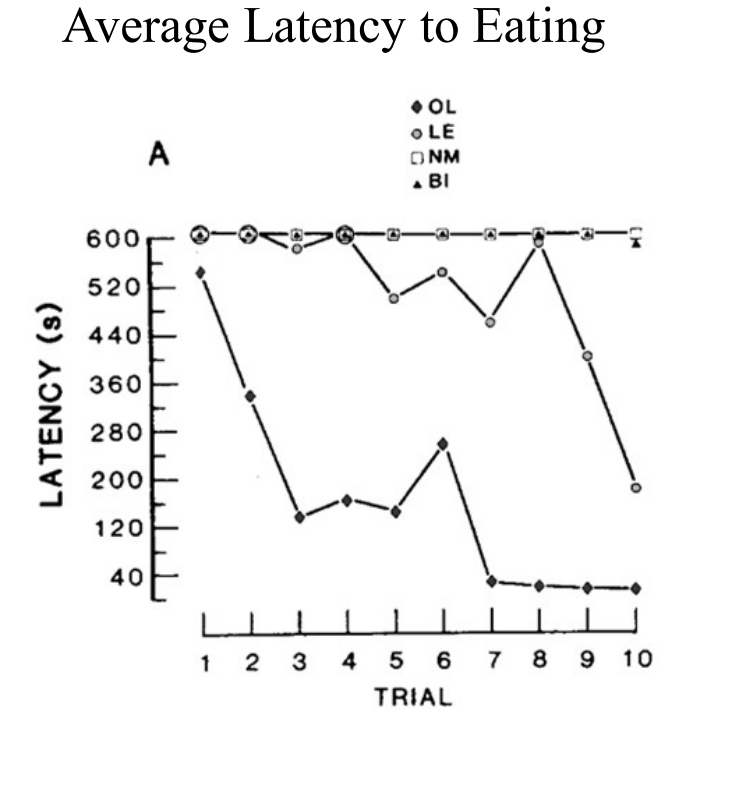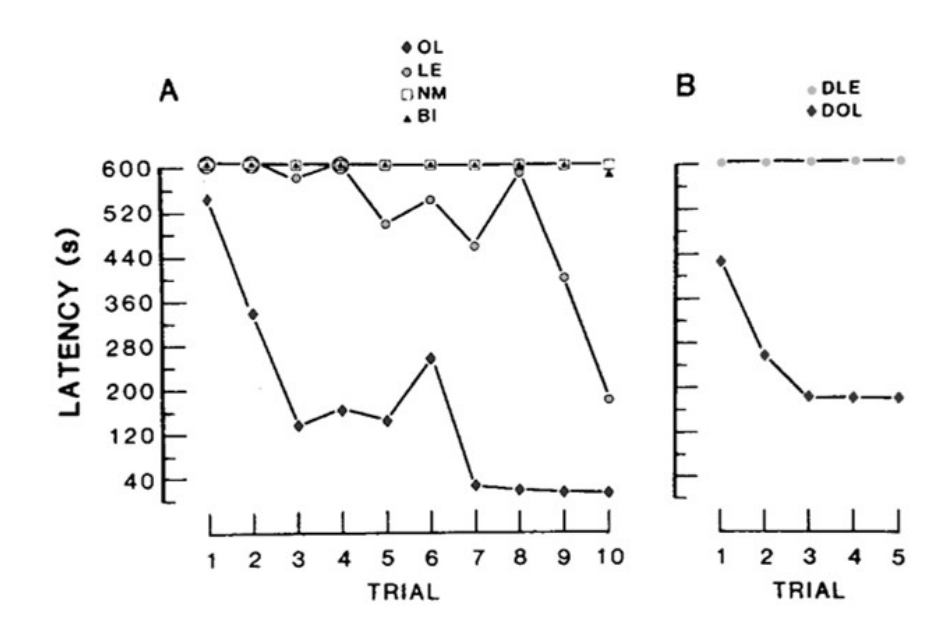Observational Learning/ Comparative Cognition
1/21
There's no tags or description
Looks like no tags are added yet.
Name | Mastery | Learn | Test | Matching | Spaced |
|---|
No study sessions yet.
22 Terms
anecdotal evidence
There is a variety of anecdotal evidence that social learning and mimicry takes place in a variety of species.
– English titmouse
– Parrots mimicry of speech.
– "Monkey see, monkey do".
– Children
evolutionary rationale
As a mechanism for acquiring adaptive behaviours, it compares favorably with other learning mechanisms.
– Speed of acquisition quicker than trial and error learning.
– Generally advantageous, or at least harmless, to copy others than be innovative.
Procedure (experiment 1) -Palameta, B. & Lefebvre, L. (1985)
Group NM (no model). Never observed the demonstrator.
Group BI (blind imitation). Observed demonstrator pierce paper, but no seed available.
Group LE (local enhancement). Observed demonstrator obtain seed, but paper pierced in advance.
Group OL (observational learning). Observed demonstrator pierce paper and eat seed.

Procedure (experiment 2) - Palameta, B. & Lefebvre, L. (1985)
Deferred Observational Learning (DOL) and
Deferred Local Enhancement (DLE), trained as before, but now tested in the model's absence.

Humans
Bandura et al. (1963, 1965) - aggression and "Bobo". Implications for modelling aggression (e.g., TV).
Bandura et al. (1967) - children's fear of dogs. Showing boy playing fearlessly with dog helped reduce fear.
Observational learning
Observational learning occurs when an organism's responding is influenced by the observation of others’ behaviour (models).
Using modelling effectively (selecting models)
Model's similarity to the observer. More likely to imitate someone who shares attributes, talents, or deficiencies with themselves
Model's competence. People who accomplish things of functional value are most likely to be good models (but not too competent).
Model's prestige. "High-ranked", "group leaders" are more likely to be modelled.
Observer's previous experience with model. Past failures/success at imitating model.
Multiple models. Several models typically exert more influence than a single one.
Applied issue
Teaching self-protection to children using television techniques (Poche et al., 1988).
Problem
Child abduction - 10% to 17% of abductions use physical force - others enticement. Not restricted to strangers but don't want indiscriminate fear of unfamiliar persons.
Follow up
Does learning generalize to new situation. Nine of the children who performed correctly were later treated with a follow-up, one month later. Situation near home, not at school. All performed the same behaviours except one, who just ran away
Clever Hans
Scientists and the public were initially impressed by his feats, but it was later discovered that Hans was not actually performing these tasks, but rather responding to subtle cues from his trainer.
Communication and Langauge
Non-human animals communicate with each other. They use smells, sounds, gestures to exchange information.
Bees: Waggle dance.
Dogs: Gestures and odours signal sexual and aggressive readiness.
Whales and dolphins: Clicks and whistles.
Vervet monkeys: Different vocalisations signal the presence of particular threats - hawk, snake, leopard.
Language in Apes - Speech
– The Kelloggs (1933) raised Gua alongside their son. Gua learned to understand some commands, but never uttered any English words.
– The Hayes (1951) raised Vicki. She learnt to make three “recognisable” words (papa, mama, and cup), but only with great difficulty and patient training.
Human Anatomy
teeth are upright, evenly spaced and touch each other.
• mouth is relatively small, can be open and shut rapidly
• lip muscles are more highly developed
• tongue is thick, muscular, and highly mobile, and can restrict the air flow in a number of ways.
Sign Langauge
In the 1960s a series of investigators tried teaching sign language to chimpanzees. The most successful was the Gardners and Washoe. Began in infancy to establish the equivalent of a parent-child bond. Washoe had a stimulating and language-rich environment.
Symbol- based langauge
Duane Raumbaugh developed “Yerkish” for Lana, Austin & Sherman. Mixed success.
Cook, & Mineka, S. (1987)
Tried to train fear of snakes in monkeys by observation.
Procedure - Videotape a monkey displaying fear to boa constrictor, and no-fear to artificial flowers. Edit the tapes.
– Group 1. Monkeys see a monkey fear artificial flowers, but show no fear to a toy snake
– Group 2. Monkeys see a monkey fear a toy snake, but show no fear to artificial flowers
Then test both groups. Monkeys must reach past a real snake, a toy snake, or artificial flowers to get food.
Fear of snakes learnt by observation, but also biological constraints - no fear of flowers learnt.
Language
Learning a set of abstract or arbitrary symbols.
– Using these symbols to express thoughts or to indicate objects and events that may or may not be present.
– Learning rules associated with the order of these symbols (syntax).
– Using syntax to generate different meaningful sentences.
During first year
Learning one word at a time. Fewer “naming” and more “action” words than human children.
By end of first year
Began making combinations of signs - “more fruit”, “out open please hurry”.
By four
Produce about 160 signs, but understanding more extensive. Although 2 and 3 word combinations occurred, little evidence of syntax.
Nim Chimpsky
1. Very low numbers of morphemes (words) per utterance.
2. Nim’s communications were much less informative than children’s.
3. No evidence of syntactic organisation.
4. Many signings seemed cued by the human teacher.
Research area became highly emotionally charged and extremely controversial.
Kanzi
mother training on keyboard, but Kanzi only sporadic interest.
At 2.5 years separated from mother - unexpected interest in keyboard.
Appeared to have about 10 symbols already. Reduced reward-based learning for more naturalistic training.
Kanzi can produce language using a lexigram vocabulary of about 200 symbols. He also refers to objects not present.
Kanzi also seems to understand simple sentences; that is, he has some grasp of syntax.
Kanzi has had his abilities to understand sentences compared to human children’s performance. He seems to be about as good as a 2, perhaps 2.5, year-old child.
Albert Bandura - Observational learning processes required:
attention - extend to which we focus on others’ behaviour
retention - retaining a representation of others’ behaviour
production - ability to actually perform actions we observe
motivation - need to perform actions we witness (usefulless)